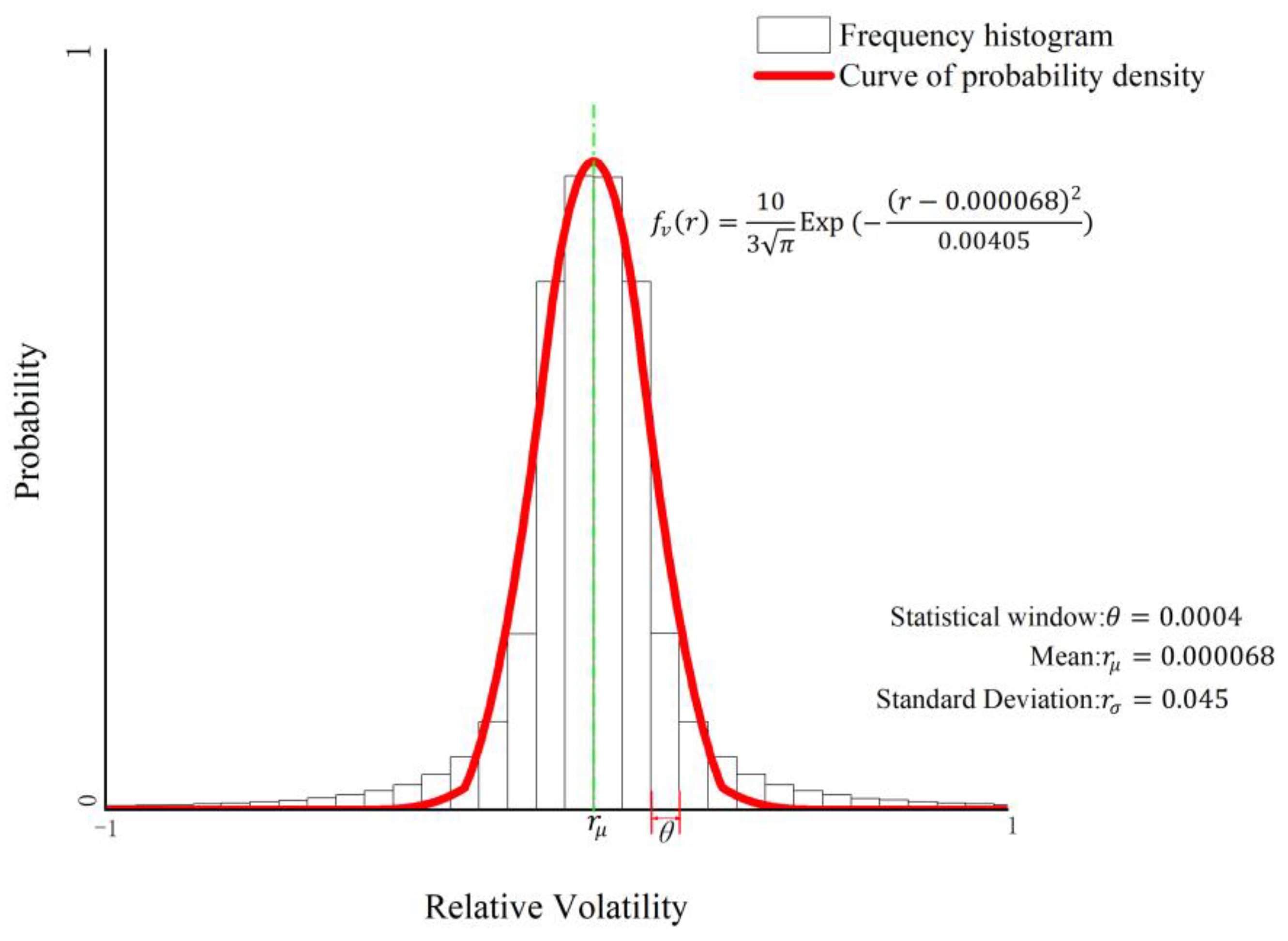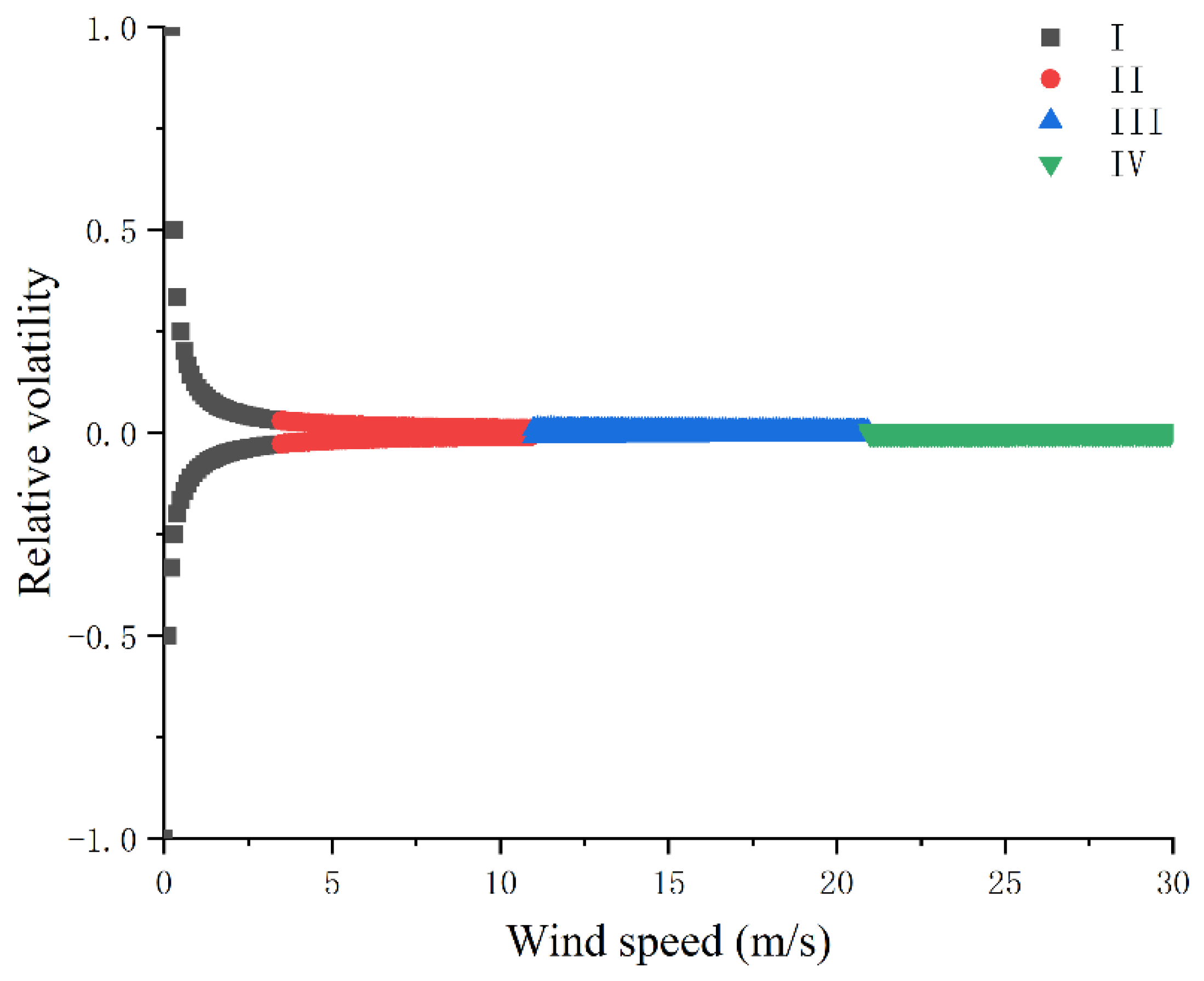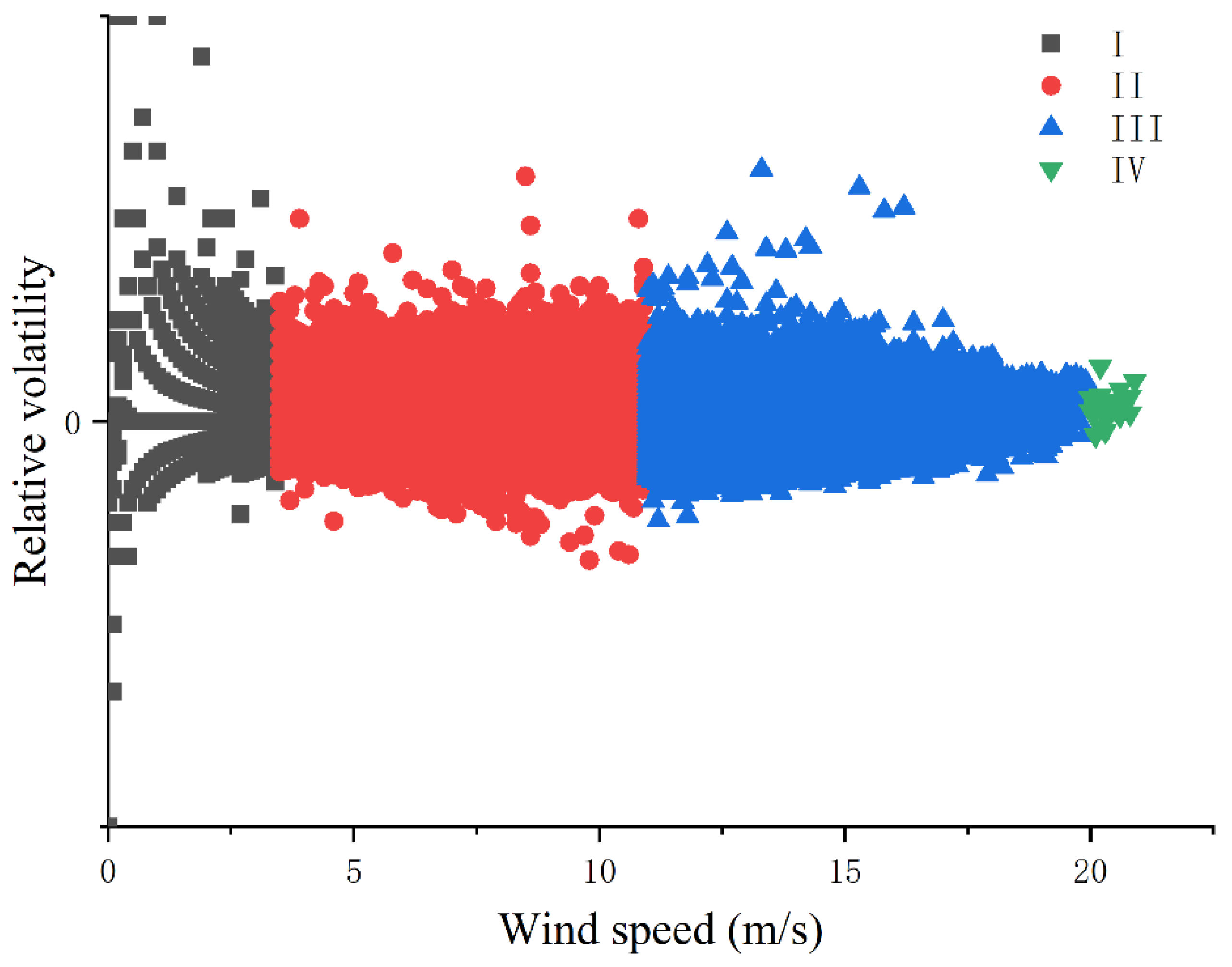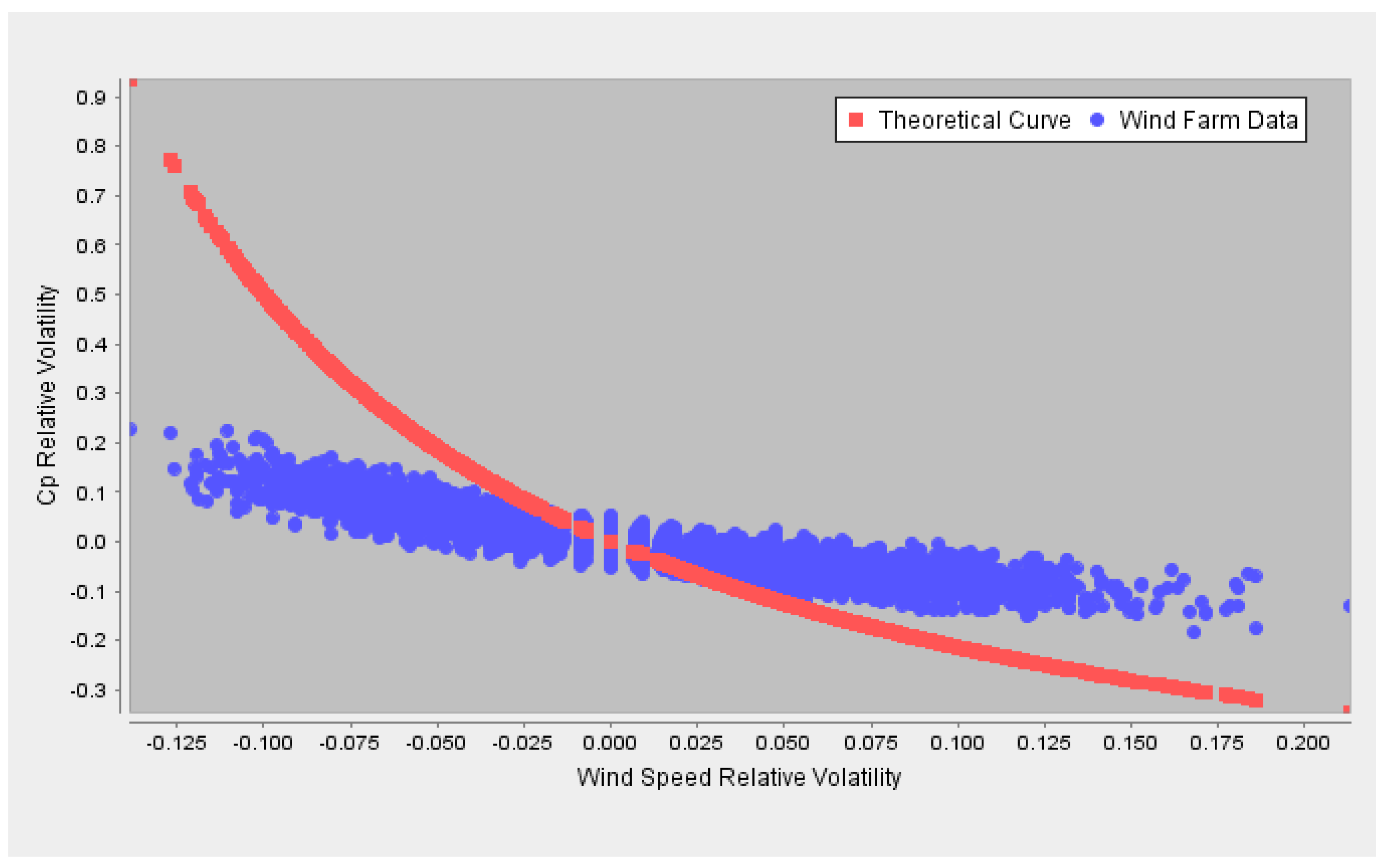Distribution Characteristics of Wind Speed Relative Volatility and Its Influence on Output Power
Abstract
:1. Introduction
2. Relative Volatility and Probability Vectors
2.1. Relative Volatility
- (1)
- Relative volatility quantifies the degree of change in a parameter’s time series, where the current moment’s volatility is related to the previous moment’s parameter value. The time series characteristics are evident;
- (2)
- By converting the dimensionless physical variables into dimensionless volatility, the issue of requiring physical significance to describe parameter-change laws is overcome;
- (3)
- The volatility of all parameters can be compared, which is conducive to the selection of key parameters and the mining of the relevant laws between parameter volatility.
2.2. Probability Vectors
2.3. Volatility Assessment Indicators
3. Wind Velocity and Feature Analysis
3.1. Feature Analysis of
3.2. Feature Analysis of
4. Correlation Analysis of Wind Velocity and Wind Turbines Power Output
4.1. The v-p Relative Volatility Correlation Analysis
4.2. Relationship Curve of and
5. Discussion
- Improvements in modeling methods based on relative fluctuation rate: current wind power curve modeling methods are mostly based on statistical methods, however, these methods have limited modeling capabilities for complex wind fields and working environments. Future research can explore new methods based on machine learning, deep learning, and other methods for the wind power relative fluctuation rate curve modeling, to improve modeling accuracy and applicability;
- Consideration of related factors: the magnitude and distribution characteristics of the relative fluctuation rate are related to multiple factors, such as wind field environment, turbine type, and turbine operation status. Future research can explore how to consider the impact of these factors on the relative fluctuation rate and incorporate them into modeling to improve the accuracy of wind-power curve modeling;
- Indepth application research: in addition to wind-power curve modeling itself, the relative fluctuation rate can also play an important role in power forecasting for wind farms, turbine health monitoring, and other applications. This work can help in the prevention of a possible blackout due to the mismatch between the production and the consumption. Future research can explore how to apply the relative fluctuation rate to more practical application scenarios to improve the economic and reliable performance of wind farms.
6. Conclusions
- Utilizing SCADA data and wind turbine runtime sequence rules, this study defined the relative volatility and its probability model -, to quantify the degree and trend of the data and converted the physical meaning parameters’ degree of change and trend into dimensionless relative volatility. Unlike the partial normal distribution of traditional wind speed, - exhibited obvious normal distribution characteristics, and its feature values could be extracted by fitting the normal distribution function. Additionally, the defined - volatility evaluation index can evaluate the relative volatility distribution characteristics of parameters in a certain time-series period, which provided a theoretical basis for an indepth analysis of the change law of wind speed and the wind-speed model;
- The statistical analysis of wind speed’s relative volatility distribution characteristics revealed significant variations in the relative volatility of different wind speed operating areas in a year. Based on the SCADA data of the wind farm, the relative volatility of Zone I fell between −0.5 and 0.75, while for Zone II and III, it ranged between −0.25 and 0.25. Zone IV exhibited fewer high wind-speed data, and its relative volatility was close to zero. The relative volatility distribution performance of different months of the year also differed: three, four, seven, nine. The relative volatility of the wind speed in 10 and 5 months was relatively concentrated, and the wind-speed change was relatively stable; The relative volatility distribution of wind speed in the 2nd, 5th, 6th, and 12th months was scattered, and the fluctuation range was large, indicating that the wind-speed change range was large. Additionally, through the six typical-distribution statistics of the small period (1 h), it was found that the wind-speed fluctuation-evaluation index and the distribution standard deviation show obvious positive proportional relationship. This means that the larger the standard deviation, the larger the eigenvalues of the evaluation index, and the more dispersed the relative volatility distribution of wind speed. Conversely, the smaller the eigenvalues of the evaluation index, the more concentrated the relative volatility distribution of wind speed;
- The relative fluctuation of the correlation between wind speed and power output was analyzed, and the relationship between wind speed and power output was derived mathematically. There was a relationship in Zone II. There was a relationship in Zone III, and the relative volatility of power and the relative volatility of the wind energy utilization coefficient could be expressed as a function of the relative volatility of the wind speed. By counting the relative volatility of the wind speed and output-power data of the onsite SCADA and calculating the fluctuation-evaluation index values respectively, it was found that the two had similar change trends;
- The magnitude and distribution characteristics of the relative fluctuation rate were related to multiple factors, such as wind field environment, turbine type, and turbine operation status. The influence of the above factors was not considered in this article. Future research can explore how to consider the impact of these factors on the relative fluctuation rate and incorporate them into modeling to improve the accuracy of wind-power curve modeling.
Author Contributions
Funding
Institutional Review Board Statement
Informed Consent Statement
Data Availability Statement
Conflicts of Interest
Abbreviations
| Symbol Name | Description |
| Output power | |
| Air density | |
| Wind turbine blade sweep area | |
| Wind energy utilization coefficient, it is a function of pitch angle and blade tip speed ratio | |
| Cut into the wind speed | |
| Rated wind speed | |
| Cut out the wind speed | |
| Rated output power | |
| Data series of SCADA parameter | |
| Time series, | |
| Relative volatility, refers to parameters in general, k refers the kth moment | |
| Probability vector of Relative volatility | |
| Relative volatility of wind speed | |
| The relative volatility of the output power | |
| Vector length of - | |
| Statistical window width factor for constructing - | |
| Vector center of - | |
| Vector offset of - | |
| Fluctuating width of - | |
| Fluctuation left border of - | |
| Fluctuation right border - | |
| Volatility assessment indicators of - |
References
- Hossain, J.; Mahmud, A. Large Scale Renewable Power Generation: Advances in Technologies for Generation, Transmission and Storage; Springer: Berlin/Heidelberg, Germany, 2014. [Google Scholar]
- Hosseini, S.H.; Tang, C.Y.; Jiang, J.N. Calibration of a Wind Farm Wind Speed Model with Incomplete Wind Data. IEEE Trans. Sustain. Energy 2014, 5, 343–350. [Google Scholar] [CrossRef]
- Carta, J.A.; Ramirez, P.; Velazquez, S. A review of wind speed probability distributions used in wind energy analysis: Case studies in the Canary Islands. Renew. Sustain. Energy Rev. 2009, 13, 933–955. [Google Scholar] [CrossRef]
- Khamees, A.K.; Abdelaziz, A.Y.; Ali, Z.M.; Alharthi, M.M.; Ghoneim, S.S.; Eskaros, M.R.; Attia, M.A. Mixture probability distribution functions using novel metaheuristic method in wind speed modeling. Ain Shams Eng. J. 2022, 13, 101613. [Google Scholar] [CrossRef]
- Sumair, M.; Aized, T.; Bhutta, M.M.A.; Siddiqui, F.A.; Tehreem, L.; Chaudhry, A. Method of Four Moments Mixture-A new approach for parametric estimation of Weibull Probability Distribution for wind potential estimation applications. Renew. Energy 2022, 191, 291–304. [Google Scholar] [CrossRef]
- Chen, H.; Anfinsen, S.N.; Birkelund, Y.; Yuan, F. Probability distributions for wind speed volatility characteristics: A case study of Northern Norway. Energy Rep. 2021, 7, 248–255. [Google Scholar] [CrossRef]
- Song, D.; Yan, J.; Zeng, H.; Deng, X.; Yang, J.; Qu, X.; Rizk-Allah, R.M.; Snášel, V.; Joo, Y.H. Topological Optimization of an Offshore-Wind-Farm Power Collection System Based on a Hybrid Optimization Methodology. J. Mar. Sci. Eng. 2023, 11, 279. [Google Scholar] [CrossRef]
- Colombo, L.; Corradini, M.L.; Ippoliti, G.; Orlando, G. Pitch angle control of a wind turbine operating above the rated wind speed: A sliding mode control approach. ISA Trans. 2020, 96, 95–102. [Google Scholar] [CrossRef] [PubMed]
- Oliveira, T.D.; Tofaneli, L.A.; Santos, A.L.B. Combined effects of pitch angle, rotational speed and site wind distribution in small HAWT performance. J. Braz. Soc. Mech. Sci. Eng. 2020, 42, 425. [Google Scholar] [CrossRef]
- Song, D.; Li, Z.; Deng, X.; Dong, M.; Huang, L.; Yang, J.; Su, M.; Joo, Y. Deep optimization of model predictive control performance for wind turbine yaw system based on intelligent fuzzy deduction. Expert Syst. Appl. 2023, 221, 119705. [Google Scholar] [CrossRef]
- Morshedizadeh, M.; Rodgers, M.; Doucette, A.; Schlanbusch, P. A Case Study of Wind Turbine Rotor Over-Speed Fault Diagnosis Using Combination of SCADA Data, Vibration Analyses and Field Inspection. Eng. Fail. Anal. 2023, 146, 107056. [Google Scholar] [CrossRef]
- Morrison, R.; Liu, X.; Lin, Z. Anomaly detection in wind turbine SCADA data for power curve cleaning. Renew. Energy 2022, 184, 473–486. [Google Scholar] [CrossRef]
- Liu, D.; Zhang, F.; Dai, J.; Xiao, X.; Wen, Z. Study of the pitch behaviour of large-scale wind turbines based on statistic evaluation. IET Renew. Power Gener. 2021, 15, 2315–2324. [Google Scholar] [CrossRef]
- Xing, Y.; Gu, Y.J.; Ma, L. Wind Turbine Status Assessment Considering Wind Speed Fluctuations. Process Autom. Instrum. 2019, 40, 28–32. [Google Scholar] [CrossRef]
- Zhang, F.; Liu, D.S.; Dai, J.C.; Wang, C.; Shen, X.B. An operating condition recognition method of wind turbine based on SCADA parameter relations. Jixie Gongcheng Xuebao/J. Mech. Eng. 2019, 55, 1–9. [Google Scholar] [CrossRef]
- Cheng, S.Y.; Liu, H.; Zeng, T.S.; Chen, H.S.; Wang, Z.; Zhu, X.N. Component importance analysis of wind turbine based on SCADA parameter relations. Renew. Energy Resour. 2021, 39, 1335–1341. [Google Scholar]
- Wang, Y.; Hu, Q.; Srinivasan, D.; Wang, Z. Wind Power Curve Modeling and Wind Power Forecasting with Inconsistent Data. IEEE Trans. Sustain. Energy 2018, 10, 16–25. [Google Scholar] [CrossRef]
- Nasery, P.; Ezzat, A.A. Yaw-adjusted wind power curve modeling: A local regression approach. Renew. Energy 2023, 202, 1368–1376. [Google Scholar] [CrossRef]
- Zha, W.; Jin, Y.; Sun, Y.; Li, Y. A wind speed vector-wind power curve modeling method based on data denoising algorithm and the improved Transformer. Electr. Power Syst. Res. 2023, 214, 108838. [Google Scholar] [CrossRef]
- Wang, Y.; Duan, X.; Zou, R.; Zhang, F.; Li, Y.; Hu, Q. A novel data-driven deep learning approach for wind turbine power curve modeling. Energy 2023, 270, 126908. [Google Scholar] [CrossRef]
- Soliman, M.S.; Belkhier, Y.; Ullah, N.; Achour, A.; Alharbi, Y.M.; Al Alahmadi, A.A.; Abeida, H.; Khraisat, Y.S.H. Supervisory energy management of a hybrid battery/PV/tidal/wind sources integrated in DC-microgrid energy storage system. Energy Rep. 2021, 7, 7728–7740. [Google Scholar] [CrossRef]
- Al Alahmadi, A.A.; Belkhier, Y.; Ullah, N.; Abeida, H.; Soliman, M.S.; Khraisat YS, H.; Alharbi, Y.M. Hybrid wind/PV/battery energy management-based intelligent non-integer control for smart DC-microgrid of smart university. IEEE Access 2021, 9, 98948–98961. [Google Scholar] [CrossRef]
- Fotis, G.; Vita, V.; Maris, T. Risks in the European Transmission System and a Novel Restoration Strategy for a Power System after a Major Blackout. Appl. Sci. 2023, 13, 83. [Google Scholar] [CrossRef]
- Vita, V.; Fotis, G.; Pavlatos, C.; Mladenov, V. A New Restoration Strategy in Microgrids after a Blackout with Priority in Critical Loads. Sustainability 2023, 15, 1974. [Google Scholar] [CrossRef]







| Relative Volatility of Wind Speed | Month | ||||||||||||
|---|---|---|---|---|---|---|---|---|---|---|---|---|---|
| Item | Area | 1 | 2 | 3 | 4 | 5 | 6 | 7 | 8 | 9 | 10 | 11 | 12 |
| Mean | I | −0.001550 | −0.001710 | −0.001852 | −0.001577 | −0.001418 | −0.001909 | −0.001786 | −0.001681 | −0.000944 | −0.001361 | −0.001652 | −0.001678 |
| II | −0.000261 | 0.000091 | 0.000422 | 0.000331 | 0.000192 | 0.000369 | 0.000807 | 0.000731 | 0.000905 | 0.000782 | 0.000536 | 0.000487 | |
| III | 0.005862 | 0.004885 | 0.006728 | 0.004337 | 0.003426 | 0.005364 | 0.006576 | 0.005709 | 0.006407 | 0.006386 | 0.004683 | 0.005331 | |
| IV | 0.037068 | 0.019473 | 0.013832 | 0.010362 | 0.012036 | 0.012622 | 0.011614 | 0.013510 | 0.010621 | 0.025797 | 0.014751 | 0.006319 | |
| Whole | 0.000395 | 0.000179 | −0.000084 | 0.000249 | 0.000471 | 0.000016 | −0.000336 | −0.000444 | 0.000116 | −0.000016 | 0.000233 | 0.000190 | |
| Standard Deviation | I | 0.051477 | 0.056840 | 0.057275 | 0.059365 | 0.060411 | 0.060675 | 0.056041 | 0.055770 | 0.049286 | 0.052240 | 0.052606 | 0.052234 |
| II | 0.039837 | 0.038228 | 0.037868 | 0.037982 | 0.042949 | 0.035521 | 0.034071 | 0.034355 | 0.034062 | 0.035907 | 0.039374 | 0.038026 | |
| III | 0.047508 | 0.042703 | 0.043123 | 0.045044 | 0.043779 | 0.041940 | 0.039807 | 0.044506 | 0.043596 | 0.041353 | 0.046660 | 0.041932 | |
| IV | 0.033130 | 0.038283 | 0.037750 | 0.049781 | 0.045769 | 0.039887 | 0.043411 | 0.063387 | 0.048829 | 0.031712 | 0.046525 | 0.008325 | |
| Whole | 0.044267 | 0.044957 | 0.046598 | 0.045729 | 0.047320 | 0.045269 | 0.045950 | 0.047375 | 0.041780 | 0.043570 | 0.044560 | 0.043274 | |
| Month of Year | Confidence Interval of Relative Volatility of Wind Speed | |||
|---|---|---|---|---|
| I | II | III | IV | |
| 1 | (−0.008388, 0.005286) | (−0.004356, 0.003833) | (0.000039, 0.011686) | (0.034236, 0.039900) |
| 2 | (−0.010046, 0.006625) | (−0.003679, 0.003862) | (0.000180, 0.009590) | (0.015692, 0.023254) |
| 3 | (−0.010316, 0.006612) | (−0.003278, 0.004122) | (0.001931, 0.011527) | (0.010155, 0.017509) |
| 4 | (−0.010671, 0.007515) | (−0.003391, 0.004053) | (−0.000898, 0.009572) | (0.003968, 0.016756) |
| 5 | (−0.010834, 0.007998) | (−0.004566, 0.004952) | (−0.001518, 0.008371) | (0.006632, 0.017441) |
| 6 | (−0.011407, 0.007589) | (−0.002886, 0.003625) | (0.000827, 0.009903) | (0.008518, 0.016728) |
| 7 | (−0.009889, 0.006316) | (−0.002188, 0.003802) | (0.002488, 0.010664) | (0.006752, 0.016477) |
| 8 | (−0.009707, 0.006343) | (−0.002314, 0.003776) | (0.000599, 0.010820) | (0.003144, 0.023876) |
| 9 | (−0.007211, 0.005323) | (−0.002088, 0.003898) | (0.001503, 0.011311) | (0.004470, 0.016773) |
| 10 | (−0.008403, 0.005679) | (−0.002544, 0.004109) | (0.001974, 0.010798) | (0.023203, 0.028392) |
| 11 | (−0.008793, 0.005487) | (−0.003464, 0.004536) | (−0.000933, 0.010301) | (0.009167, 0.020336) |
| 12 | (−0.008718, 0.005361) | (−0.003243, 0.004219) | (0.000795, 0.009868) | (0.006141, 0.006499) |
| Month of Year | ||||||||
|---|---|---|---|---|---|---|---|---|
| _ | 4.266961 | 46 | 23 | 3 | 45 | −0.020921 | 0.023314 | 1.114382 |
| _ | 5.057571 | 46 | 23 | 19 | 29 | −0.021370 | 0.020081 | 0.939711 |
| _ | 1.815011 | 46 | 23 | 22 | 23 | −0.021680 | 0.008564 | 0.395008 |
| _ | 1.802787 | 46 | 23 | 22 | 23 | −0.021695 | 0.008560 | 0.394555 |
| _ | 5.858974 | 46 | 23 | 20 | 43 | −0.021586 | 0.017001 | 0.787612 |
| _ | 5.249016 | 46 | 23 | 22 | 25 | −0.021623 | 0.011945 | 0.552391 |
| _ | 1.822909 | 46 | 23 | 22 | 23 | −0.021654 | 0.008558 | 0.395228 |
| _ | 4.681096 | 46 | 23 | 11 | 45 | −0.021085 | 0.022378 | 1.061353 |
| _ | 1.831810 | 46 | 23 | 22 | 23 | −0.021644 | 0.008561 | 0.395558 |
| _ | 1.804647 | 46 | 23 | 22 | 23 | −0.021659 | 0.008544 | 0.394478 |
| _ | 4.904980 | 46 | 23 | 22 | 24 | −0.021634 | 0.011479 | 0.530598 |
| _ | 6.025606 | 46 | 23 | 21 | 24 | −0.021569 | 0.013648 | 0.632747 |
Disclaimer/Publisher’s Note: The statements, opinions and data contained in all publications are solely those of the individual author(s) and contributor(s) and not of MDPI and/or the editor(s). MDPI and/or the editor(s) disclaim responsibility for any injury to people or property resulting from any ideas, methods, instructions or products referred to in the content. |
© 2023 by the authors. Licensee MDPI, Basel, Switzerland. This article is an open access article distributed under the terms and conditions of the Creative Commons Attribution (CC BY) license (https://creativecommons.org/licenses/by/4.0/).
Share and Cite
Qin, S.; Liu, D. Distribution Characteristics of Wind Speed Relative Volatility and Its Influence on Output Power. J. Mar. Sci. Eng. 2023, 11, 967. https://doi.org/10.3390/jmse11050967
Qin S, Liu D. Distribution Characteristics of Wind Speed Relative Volatility and Its Influence on Output Power. Journal of Marine Science and Engineering. 2023; 11(5):967. https://doi.org/10.3390/jmse11050967
Chicago/Turabian StyleQin, Shigang, and Deshun Liu. 2023. "Distribution Characteristics of Wind Speed Relative Volatility and Its Influence on Output Power" Journal of Marine Science and Engineering 11, no. 5: 967. https://doi.org/10.3390/jmse11050967
APA StyleQin, S., & Liu, D. (2023). Distribution Characteristics of Wind Speed Relative Volatility and Its Influence on Output Power. Journal of Marine Science and Engineering, 11(5), 967. https://doi.org/10.3390/jmse11050967






